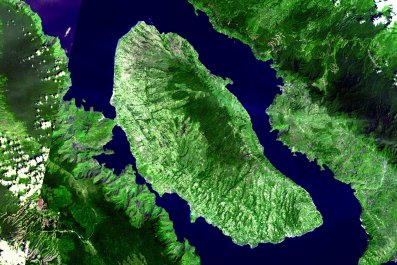Millions of tons of plastic makes its way into the oceans every year, but once it gets there, scientists still don't know precisely what happens to it. They know it can break down into smaller pieces of plastic but never actually decompose; it can kill a wide variety of animals. But it's hard to see, so they don't know where it goes or how long it stays there.
Now, scientists at the European Space Agency want to use a satellite to help get a better handle on these questions. If the project is successful, it could be the first global effort to measure how much plastic is where across the oceans.
"I think what's been so challenging about characterizing the plastic floating in the ocean is that the ocean is so vast," Jenna Jambeck, who studies waste at the University of Georgia and who isn't involved with the project, told Newsweek. "It's been pretty difficult to sort of wrap your hands around this issue globally in terms of sources, sinks, quantification and that sort of thing."
Current plastic monitoring programs all fall short of a global scale; there are only local and regional programs, which present major gaps. "Boy, what an advance it would be to be able to see the world in a snapshot," said James Carlton, an ecologist at Williams College who has studied how plastic moves species around the globe.
The team wants to build a machine that can identify plastic by spotting distinctive characteristics in light reflecting off it. Scientists such as the University of Connecticut's Heidi Dierssen are already working on making that technique a reality using airplane surveys.
Read more: Ocean Pollution: Even Sea Creatures in the Deepest, Darkest Trenches Are Full of Plastic
The approach relies on plastic reflecting more invisible light in the inftared spectrum back to the sky than the ocean itself does. If there's enough plastic in one area, scientists armed with imaging technology can identify and measure plastic based on those light signatures.
Of course, it gets complicated. "To know that it's actually plastic and not something else floating or even a bubble or a whitecap, we have to have more of a sense of the spectral fingerprint and what's unique to plastics," Dierssen said. "It's going to be very challenging."
No matter how well they hone the approach, it will never let scientists peer below the ocean's surface.

That said, if the scientists can get the method to actually work, it could still be a valuable source of data when they design studies dealing with ocean plastic. Jennifer Provencher, a marine biologist at Acadia University in Canada, studies how plastic affects species like seabirds. She thinks data from this project could flag key areas with very high levels of plastic where she could recruit partners to collect fish to see how much plastic is inside them.
And she added that this sort of large scale project is particularly valuable since plenty of plastic pollution is in international waters, beyond any given country's borders. "This is a way that monitoring in those international waters could be done by international organizations."















